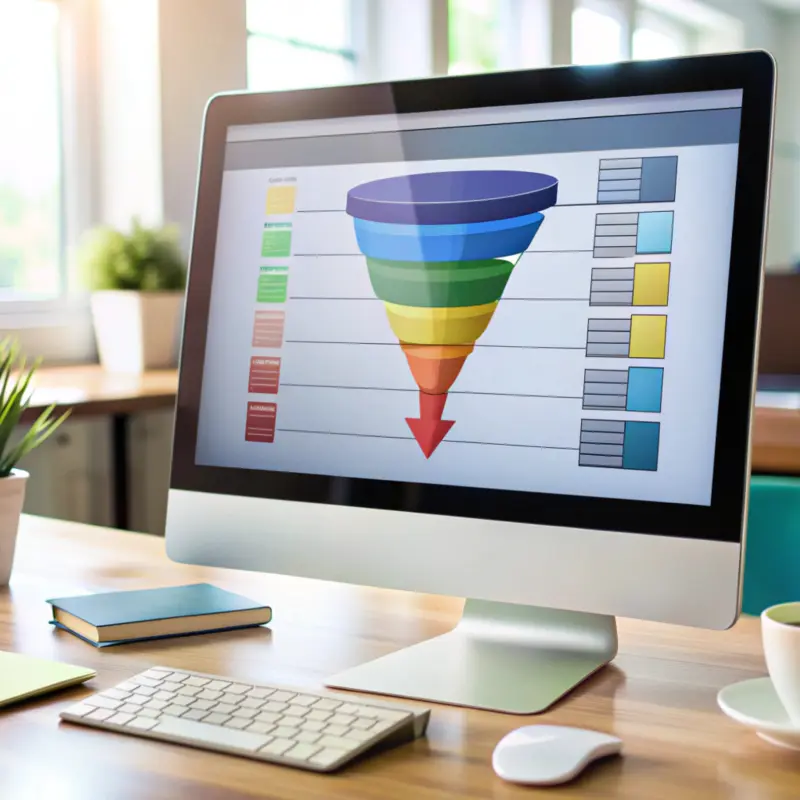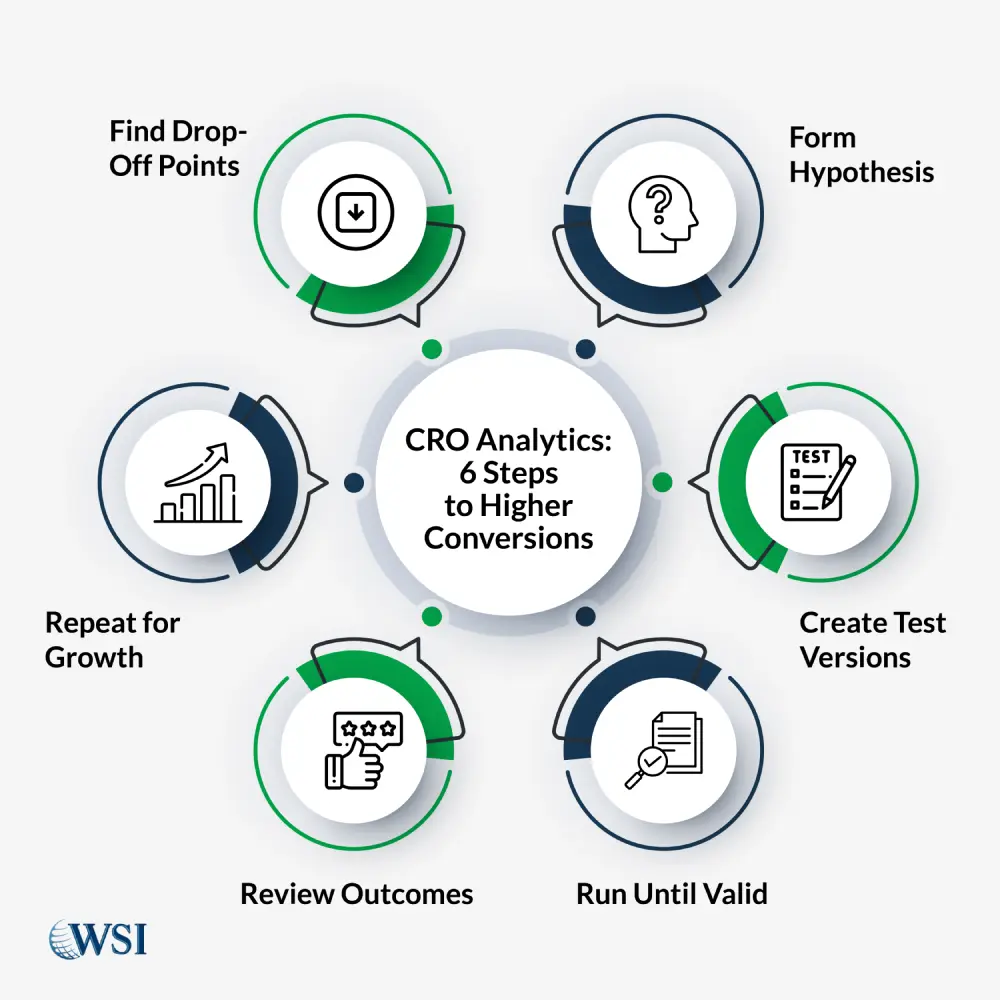If you want to turn your website into a true conversion engine, you need CRO analytics. It’s the difference between making educated business decisions and running marketing on gut feelings. Analytics doesn’t just tell you what’s happening, it shows you why it’s happening, where you’re losing potential sales, and how to fix it. That’s how you stop wasting ad spend, optimize every visitor touchpoint, and create predictable revenue growth.
Contents
Key Takeaways
- CRO analytics gives you a clear, data-backed roadmap to improve conversions and ROI.
- Tracking precise conversion tracking metrics keeps your focus on actions that directly impact revenue.
- Converting website analytics for CRO into structured experiments drives measurable business gains.
Why Metrics Matter: CRO Without Analytics Is Guesswork
Running marketing without analytics is like adjusting a ship’s course without a compass. You may move, but you have no proof you’re heading in the right direction. Businesses that operate this way often pour budget into the wrong channels, tweak designs that were already working, and overlook problems until they cost thousands in lost revenue.
Every interaction on your site leaves behind data. This includes which channels bring visitors, how they move through your pages, where they hesitate, and when they decide to leave. When you analyze that information, you can spot patterns, both the winning plays and the friction points holding you back.
CRO analytics is more than tracking numbers. It’s about identifying what truly influences a customer’s decision to convert. That means:
- Detecting drop-offs early so you can act before sales decline.
- Using behaviour analytics tools to pinpoint why visitors hesitate.
- Designing tests based on hard evidence rather than personal preference.
Without metrics, you’re guessing. With them, you’re making calculated moves that deliver measurable impact.

Make your analytics work harder for you.
Discover how our business strategy services can turn raw data into revenue-driving action plans.
Core Metrics to Track: Sessions, Bounce Rate, Time on Page
You can’t manage what you don’t measure. Every CRO strategy starts with a foundation of reliable conversion tracking metrics. These three sessions, bounce rate, and time on page act as your vital signs, revealing the overall health of your site before you run deeper analysis.
Sessions: The Starting Point of All Analysis
Think of sessions as the raw foot traffic to your online store. Without this number, you can’t put other metrics into context. A sudden drop in conversions might be due to a decline in traffic, not necessarily a flaw in your page design.
Tracking sessions in GA4 for CRO gives you insights into:
- Audience growth or decline over time.
- The impact of seasonal campaigns or promotions.
- Where the most valuable traffic is coming from.
When you know where traffic comes from and how it fluctuates, you can prioritize optimization where it matters most.
Bounce Rate: Your Silent Conversion Killer
A bounce happens when someone lands on your page and leaves without engaging further. High bounce rates often mean the content isn’t meeting expectations, the page loads too slowly, or the layout overwhelms visitors.
With behaviour analytics tools, you can see if people scroll, where they stop, and whether they click anything before leaving. If your PPC landing page has a bounce rate above 70%, you’re losing a large share of paid traffic before it even enters your funnel.
Time on Page: Engagement’s Telltale Sign
Time on page reflects how long visitors stay on a specific page. Short times may indicate that the content isn’t engaging or that it fails to guide users toward the next step.
You can increase time on page by:
- Breaking content into shorter, visually appealing sections.
- Adding interactive elements like videos or comparison tables.
- Ensuring your most persuasive content appears above the fold.
When people spend longer engaging with your content, they’re more likely to convert.
How These Metrics Work Together in CRO Analytics
Individually, each metric tells part of the story. Together, they give you a complete view of how users interact with your site. For example, a drop in conversions alongside stable sessions but rising bounce rates points to a page-level engagement issue. Low time on page paired with high bounce rates could indicate that your content or offer fails to capture attention quickly enough.
By analyzing these metrics in unison, you can pinpoint the root causes of conversion challenges, prioritize fixes, and measure the direct impact of your changes. This interconnected view is at the heart of CRO analytics, ensuring every optimization decision is based on the full picture, not isolated data points.

Stop guessing which metrics matter.
See exactly where your CRO funnel tracking breaks, and how to fix it, with our expert analytics support.
Goal Tracking: Setting Up Macro and Micro Conversions
Without clear goals, analytics is just a mass of disconnected data points. Goals give that data purpose, turning it into a scoreboard that tells you exactly when you’ve succeeded and where your strategy needs refinement. In CRO, tracking both macro and micro conversions is the difference between seeing the big picture and understanding the individual plays that get you there.
Macro Conversions: The Main Event
Macro conversions represent the primary objectives of your site, completed sales, booked consultations, or demo requests. They are the ultimate indicators of revenue impact. Tracking macro conversions through CRO funnel tracking allows you to map each step of the buyer’s journey, identify where people drop off, and see how changes directly influence these core outcomes. For example, you might discover that 30% of potential buyers leave at the payment stage, signalling an opportunity to streamline checkout or offer more payment options.
Accurate macro tracking also helps allocate resources effectively. You can see which campaigns drive the most high-value actions and invest more in what’s working.
Micro Conversions: The Stepping Stones
Micro conversions are the smaller actions that build toward macro results. They might include subscribing to a newsletter, downloading a guide, engaging with a product video, or adding an item to the cart. While they don’t immediately generate revenue, they measure user engagement and intent, critical indicators of future sales.
Using website analytics for CRO, you can assign a notional value to each micro conversion, reflecting its contribution toward the final purchase. This helps you understand which user behaviours are most predictive of eventual revenue and ensures that early engagement steps are optimized, not ignored. Over time, improving micro conversions shortens the path to macro conversions, creating a smoother, more efficient funnel.
When both macro and micro goals are tracked together, you gain a complete view of performance, from first interaction to final sale, enabling smarter decisions and consistent growth.
Harmony Between Macro and Micro Conversions
Macro and micro conversions are two sides of the same coin. Macro conversions tell you if your site is achieving its primary revenue goals. Micro conversions reveal the steps users take along the way and highlight areas where you can improve engagement before they reach the final stage.
Together, they provide a complete narrative: micro conversions indicate progress toward macro goals, while macro results validate the effectiveness of your smaller engagement tactics. In CRO analytics, this dual perspective ensures you’re not only measuring end results but also optimizing the touchpoints that influence them, leading to a more predictable and scalable path to higher conversions.

Let’s define what success looks like for your site.
We’ll set up macro and micro goals in your analytics so every step toward a sale gets tracked.
Turning Analytics Into Actionable Tests

Data by itself is like a map without directions; you can see the terrain, yet you have no clear route to your destination. The real value emerges when you translate those numbers into structured experiments that actively improve your results. This is where you stop observing and start steering. When analytics drives testing, you replace uncertainty with deliberate action.
Turning CRO analytics into high-ROI experiments means building a repeatable process that’s grounded in data and focused on measurable impact. That process looks like this:
- Spot a Weak Point: Use detailed funnel data to pinpoint where users drop off most often. This could be a checkout page, a form, or even a critical landing page.
- Form a Hypothesis: Base your theory on observed behaviour, not guesswork. For example, if heatmaps show visitors abandoning a form halfway through, reducing the number of fields from 7 to 4 might increase completions by 15%.
- Create a Test: Build two clear versions of the page: the existing one and the modified version addressing your hypothesis. Keep every other element consistent so you isolate the variable being tested.
- Run the Test Properly: Allow enough time for a statistically reliable sample. Premature conclusions can be as misleading as no data at all.
- Review the Results: Identify the winner and analyze why it performed better. Understanding the “why” behind results informs future tests.
- Document and Repeat: Log every test, outcome, and insight. Over time, this record becomes a playbook for improving conversion rates consistently.
Structured testing ensures each change is purposeful. Instead of chasing random ideas, you create a cycle where insights lead to actions, actions lead to measurable results, and results fuel the next round of improvements.
Driving Conversions with CRO Analytics for Proactive Growth
CRO analytics is your competitive edge. It tells you exactly which changes will drive more conversions, which campaigns deserve more budget, and where customers need a smoother path to purchase. When you combine the right conversion tracking metrics, precise goal setting, and tools like GA4 for CRO and behaviour analytics tools, you move from reactive fixes to proactive growth. If you’re ready to turn raw data into measurable revenue gains, start the conversation today and put analytics at the center of your strategy.

Ready to turn numbers into higher conversions?
We’ll guide you through analytics-based testing that delivers measurable ROI.

